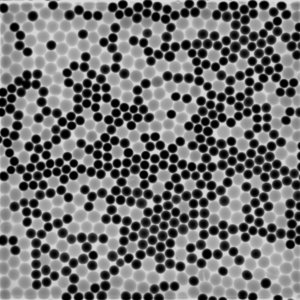Jamming and Granular Physics
Amorphous materials display a rich spectrum of nonequilibrium, many-body physics. Perhaps the most striking property of amorphous materials is the ability to smoothly transition from a owing to a rigid state. Examples cover a wide range of time and length scales, from molecular glasses to solutions of microscopic colloidal particles and collections of large granular particles. In fact, materials such as glasses, foams, gels, emulsions, dense suspensions, and sand grains all share strong similarities in their dynamics. Upon an increase in density or a reduction in temperature or external stress, these materials can become jammed and resist further motion. In our lab we study the fundamental physics of amorphous, granular systems. On the left is a two-dimensional suspension of near-frictionless hydrogel particles, each about 1 cm in size. The movie on the right shows a simulation of an impact of two granular clusters, and the color shows a front of energy loss propagating through the clusters.
Casimir effect between pinned particles in two-dimensional jammed systems
J. J. Liétor-Santos and J. C. Burton. Soft Matter (2017). DOI: 10.1039/C6SM02072K
Energy Loss at Propagating Jamming Fronts in Granular Gas Clusters
J. C. Burton, P. Y. Lu, and S. R. Nagel. Physical Review Letters 111, 188001 (2013).
Casimir effect between pinned particles in two-dimensional jammed systems
J. J. Liétor-Santos and J. C. Burton. Soft Matter (2017). DOI: 10.1039/C6SM02072K
Energy Loss at Propagating Jamming Fronts in Granular Gas Clusters
J. C. Burton, P. Y. Lu, and S. R. Nagel. Physical Review Letters 111, 188001 (2013).
